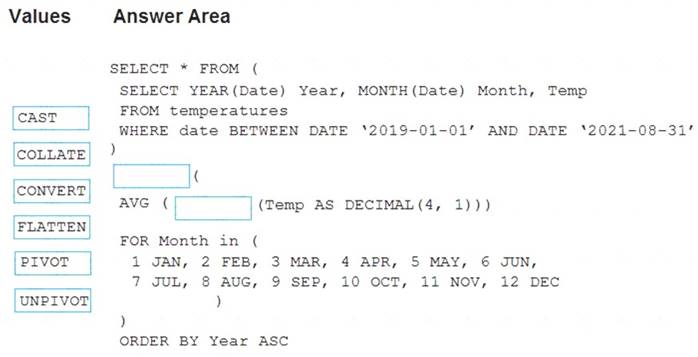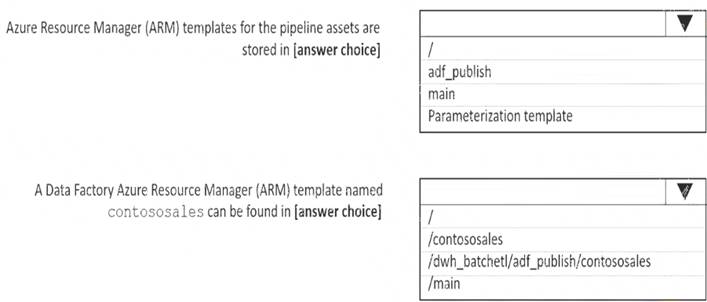- (Exam Topic 3)
You configure version control for an Azure Data Factory instance as shown in the following exhibit.
Use the drop-down menus to select the answer choice that completes each statement based on the information presented in the graphic.
NOTE: Each correct selection is worth one point.
Solution:
Letter Description automatically generated
Box 1: adf_publish
The Publish branch is the branch in your repository where publishing related ARM templates are stored and updated. By default, it's adf_publish.
Box 2: / dwh_batchetl/adf_publish/contososales
Note: RepositoryName (here dwh_batchetl): Your Azure Repos code repository name. Azure Repos projects contain Git repositories to manage your source code as your project grows. You can create a new repository or use an existing repository that's already in your project.
Reference:
https://docs.microsoft.com/en-us/azure/data-factory/source-control
Does this meet the goal?
Correct Answer:
A
- (Exam Topic 3)
You are monitoring an Azure Stream Analytics job.
You discover that the Backlogged Input Events metric is increasing slowly and is consistently non-zero. You need to ensure that the job can handle all the events.
What should you do?
Correct Answer:
B
Backlogged Input Events: Number of input events that are backlogged. A non-zero value for this metric implies that your job isn't able to keep up with the number of incoming events. If this value is slowly increasing or consistently non-zero, you should scale out your job. You should increase the Streaming Units.
Note: Streaming Units (SUs) represents the computing resources that are allocated to execute a Stream Analytics job. The higher the number of SUs, the more CPU and memory resources are allocated for your job.
Reference:
https://docs.microsoft.com/bs-cyrl-ba/azure/stream-analytics/stream-analytics-monitoring
- (Exam Topic 3)
You have an Azure Data Lake Storage Gen 2 account named storage1.
You need to recommend a solution for accessing the content in storage1. The solution must meet the following requirements: List and read permissions must be granted at the storage account level.
List and read permissions must be granted at the storage account level.  Additional permissions can be applied to individual objects in storage1.
Additional permissions can be applied to individual objects in storage1. Security principals from Microsoft Azure Active Directory (Azure AD), part of Microsoft Entra, must be used for authentication.
Security principals from Microsoft Azure Active Directory (Azure AD), part of Microsoft Entra, must be used for authentication.
What should you use? To answer, drag the appropriate components to the correct requirements. Each component may be used once, more than once, or not at all. You may need to drag the split bar between panes or scroll to view content.
NOTE: Each correct selection is worth one point.
Solution:
Box 1: Role-based access control (RBAC) roles
List and read permissions must be granted at the storage account level.
Security principals from Microsoft Azure Active Directory (Azure AD), part of Microsoft Entra, must be used for authentication.
Role-based access control (Azure RBAC)
Azure RBAC uses role assignments to apply sets of permissions to security principals. A security principal is an object that represents a user, group, service principal, or managed identity that is defined in Azure Active Directory (AD). A permission set can give a security principal a "coarse-grain" level of access such as read or write access to all of the data in a storage account or all of the data in a container.
Box 2: Access control lists (ACLs)
Additional permissions can be applied to individual objects in storage1. Access control lists (ACLs)
ACLs give you the ability to apply "finer grain" level of access to directories and files. An ACL is a permission construct that contains a series of ACL entries. Each ACL entry associates security principal with an access level.
Reference: https://learn.microsoft.com/en-us/azure/storage/blobs/data-lake-storage-access-control-model
Does this meet the goal?
Correct Answer:
A
- (Exam Topic 3)
You have an Azure Synapse Analytics dedicated SQL pool.
You need to ensure that data in the pool is encrypted at rest. The solution must NOT require modifying applications that query the data.
What should you do?
Correct Answer:
B
Transparent Data Encryption (TDE) helps protect against the threat of malicious activity by encrypting and decrypting your data at rest. When you encrypt your database, associated backups and transaction log files are encrypted without requiring any changes to your applications. TDE encrypts the storage of an entire database by using a symmetric key called the database encryption key.
Reference:
https://docs.microsoft.com/en-us/azure/synapse-analytics/sql-data-warehouse/sql-data-warehouse-overviewmana
- (Exam Topic 3)
You are monitoring an Azure Stream Analytics job.
The Backlogged Input Events count has been 20 for the last hour. You need to reduce the Backlogged Input Events count.
What should you do?
Correct Answer:
C
General symptoms of the job hitting system resource limits include: If the backlog event metric keeps increasing, it’s an indicator that the system resource is constrained (either because of output sink throttling, or high CPU).
If the backlog event metric keeps increasing, it’s an indicator that the system resource is constrained (either because of output sink throttling, or high CPU).
Note: Backlogged Input Events: Number of input events that are backlogged. A non-zero value for this metric implies that your job isn't able to keep up with the number of incoming events. If this value is slowly increasing or consistently non-zero, you should scale out your job: adjust Streaming Units.
Reference:
https://docs.microsoft.com/en-us/azure/stream-analytics/stream-analytics-scale-jobs https://docs.microsoft.com/en-us/azure/stream-analytics/stream-analytics-monitoring